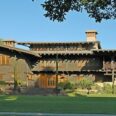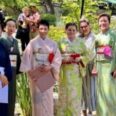
The AAReST spacecraft as envisioned by the 2011 Ae105 class. [Credit: Ae105 class/Keith Patterson]
Forget problem sets and exams. For their homework and final assignments, students in Caltech’s Aerospace Engineering course (Ae105) work on a proposed space mission. For the past few years, students in the class have helped design, prototype, and test various pieces of AAReST, a space-telescope demonstration mission currently under development.
“It’s really different from all of our other classes,” says graduate student Manan Arya, who took the course this year. “You’re actually doing work that’s going to go into space. It’s really exciting.”
Space-based optical telescopes with large primary mirrors or lenses hold promise for expanding human knowledge of Earth and the universe. Larger primary optics allow telescopes to gather more light, and therefore, to peer farther into the cosmos. Currently, the push is to develop space-based telescopes with primary optics larger than 10 meters in diameter (in comparison, the Hubble Space Telescope’s primary mirror has a diameter of 2.4 meters). At the moment, though, the size of the mirrors is limited by the diameter of their launch vehicles. One way around the problem? Launch many small, independent spacecraft, each outfitted with its own mirror. Once in orbit, these craft would reconfigure themselves into a single large, segmented aperture.

The latest concept for the AAReST spacecraft in the stowed configuration. Four small spacecraft with mirrors on top are shown attached to the center “nanosat,” which holds the folded boom and optics package. The front two spacecraft would be capable of separating from the cluster and redocking on the sides. [Credit: Ae105 class/Keith Patterson]
AAReST (Autonomous Assembly of a Reconfigurable Space Telescope) is a low-cost mission intended to demonstrate the feasibility of this concept. Now in the pre-mission phase, AAReST has a projected launch date of 2015.
Seizing the opportunity to give students some hands-on experience, Sergio Pellegrino, Caltech’s Joyce and Kent Kresa Professor of Aeronautics and professor of civil engineering, who is also a senior research scientist at the Jet Propulsion Laboratory (JPL), worked the mission into the Ae105 curriculum. His partners in this effort are JPL engineers Behcet Acikmese, Greg Davis, and Yunjin Kim. The year-long course they devised is fairly traditional for the first term and a half, and then switches to a project-based course to fill out the year.
Recently, this year’s students presented the results of their final projects, which involved everything from designing and testing a new method for deploying the spacecraft boom to developing an algorithm to correct the telescope’s focusing errors. Prior to the presentations, Pellegrino praised the students for their hard work and creativity. “They have moved the mission forward by a huge step this year, and I thank them for this,” he said.
The efforts of the Ae105 students provide a burst of energy for the team that works on AAReST during the rest of the year, Pellegrino says. In past years, the class devised a completely new configuration for the spacecraft; this year, they refined it. “The initial concept has been transformed by the students’ input,” Pellegrino says.
In addition to being advised by the instructors, the students are mentored by several former Ae105 students and other JPL employees. One of Manan’s mentors was retired JPLer Jim Breckinridge, who managed the team that built the camera that corrected the Hubble Space Telescope’s originally flawed vision.
“When somebody has that much experience, and they’re right next to you on the experimental setup, helping you out one-on-one—that’s a rare opportunity,” Manan says. “And it’s a lot of fun.”
The AAReST mission is a collaborative effort between Caltech, JPL, and the University of Surrey, in England. The pre-mission’s project manager is JPL’s John Baker. The Ae105 class has received funding from the Keck Institute for Space Studies, Caltech’s Division of Engineering and Applied Science, and the Innovation in Education Fund, which was made possible in part by the Caltech Associates.













 0 comments
0 comments


